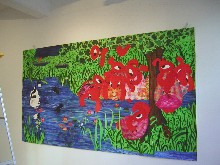
Here’s a belated list of some of the local art I saw at First Friday that either made mre fall in love or piqued my interest:
At Vox Populi, Samantha Simpson’s storybook fantasy paintings, “The Problem of Prevost’s Squirrel,” continue Simpson’s exploration of what is scary and familiar and beautiful all at once. The menace this time is in a swarm of evil-eyed, stylized squirrels that verge on the abstract. The work is heartfelt and suggests way more than meets the eye at first.
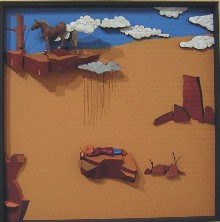
And William Lohre, who in his last Vox outing had made literal models in achingly obsessive detail, has figured out that literal is not the way to go. This work is break-through, and I can’t wait to see more. He creates dream-space diaramas that include cowboy sunsets, Medieval fortifications and 1950s space stations. Big sky is a repeating theme, and so are movie-land inspirations.
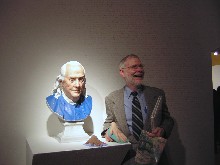
Another place to visit is Nexus for its Benjamin Franklin: An American Idol exhibition, its contribution to the citywide Ben Franklin 300 Philadelphia celebration. Check out this realistic bust of Ben in silicone, based on the PMA’s Houdon bust. Next to Ben stands the sculptor and willing model, Robert A. Erb, Ph.D., whose normal approach to sculpture is making prosthetics of silicone. So he brought along a couple of hands to show a little more about his method. Eek.
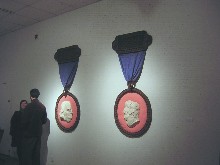
Ryan Kelley’s giant medallions, Ben & Aretha, combine giant cameo reliefs with Cordons of the Order of National Treasures. The pairing is the timeline of American culture in relief.

And Jody Sweitzer’s old phone booth with video of lips looked great from without. What secret were those lips imparting on the telephone, I wondered. Inside, I got to listen to the lips message–Franklin’s list of 13 virtues, described in more detail than I was ready to absorb. The silent visual worked best for me. But then again, this was a show about Franklin.
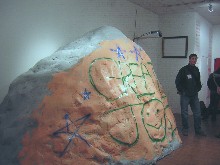
Nick Paparone and Jamie Dillon’s Everest (see post) experiences a second coming here, the mountain transformed into a roadside boulder with graffiti, an exuberant expression of freedom of speech. Memories of family trips past the graffitied boulders of the New Jersey Pallisades popped right up. The graffiti, back then, was mysterious to me, messages from some teenage tribe whose rituals and words defied interpretation. This thing captures that.
The show also includes lots of interactive stuff with lots of words, more than I personally was able to digest on a First Friday with crowds galore. But you can tag your photographs on Flickr with “democracy” and perhaps have them flashed on a slide show that included words in some Asian language that suggested to me how little we value our own freedom of speech.
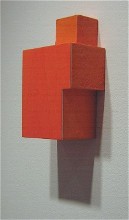
On the other end of the aesthetic scale, David Goerk’s what-is-its at Larry Becker. Goerk is again showing tiny constructions of wood coated with encaustic. These are less drippy and iced than previous ones, but the color is cranked up to new heights, with multiple shades in some cases. The work is wall anti-jewelry, the materials a cry against ultra-refinement. The pieces remind me of precocious but charming children, sure of their own worth and not shy in the least. They demand love at the same time that they refuse to prove themselves, positive that their material presence is all that is needed. They’re right.

Over at Drizzle, which is still getting its sea legs, a suite of photographs by Jill Galloway with child-like houses scratched or drawn on reminded me in methodology of the ultra-hip slide show of Grady Gerbracht’s trip in which he traces what’s outside on the bus windows (see post).
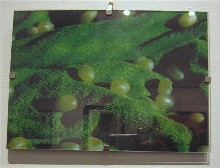
Some loopy takes on still life by Andrea Mozen also caught my attention. The small photograph of grapes on the draped astroturf become dinosaur eggs or mutant golf balls, and the rotting fruit blends with fabric patterns or looks positively sexy amid folds of fabric. The work emphasizes the mort in nature mort. I’m sorry about the reflections in the bottom part of this image.

At Carbon 14, some of Annelise Ream’s paintings in her exhibit Systems of Suffering and Redemption go unexpected places, with ritualistic sacrifice and ritualistic scientific exploration mixed with diagrammatic maps of sacred spaces.









